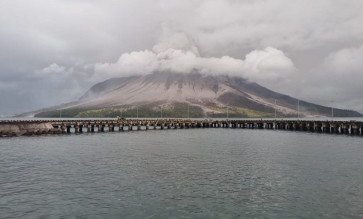Making crafts from whatever comes to hand
Productive pastime: Young mothers are spending their time working on handicrafts at Agus Hidayat’s workshop
Change Size

Productive pastime: Young mothers are spending their time working on handicrafts at Agus Hidayat’s workshop.
Banana leaves tend not to be associated with aesthetic pleasure or top dollar. But in the right hands, the humble banana leaf gets a new lease of life - as a decoration on ornamental pots.
And not just banana leaves. Any leaves, discarded banana stems, bamboo shavings - any plant matter is fair game for artisans Orbawanto and Agus Hidayat, whose artistic touch turns waste into gold.
The two use the organic waste to decorate simple, plain-colored vases. The result of their creativity is distinctive, beautiful pieces, with motifs and colors finding favor among customers all over the world.
"The market for our products has yet to be fully satisfied," said 36-year-old Agus, in his workshop in Kampung Samen in Bambanglipuro, Bantul. "The orders keep coming. We're often overwhelmed with orders."
Orbawanto, 44, and Agus began their business together in 2004. They began by making plaited handicrafts using bamboo and rattan as their raw materials. Three years later, they turned to adorning vases with decorations made from vegetable waste for the simple reason that the materials were cheap and easy to find - after all, there was plenty of rubbish around their village area. They found that the plants lent their products interesting textures and colors.
The raw materials for the vases come from the rubbish discarded by craftsmen in the Pundong area in Bantul.
Agus designs the vases, with the price he pays for the basic product depending on the size. The smallest, about 20 centimeters high, cost Rp 5,000 each, with the largest costing around Rp 15,000 per vase.
As for the raw materials, he just picks up whatever is lying around and thrown out, and there is plenty of it. Any kind of leaf will do, Agus said, provided it has a good color and texture, and will adhere to the pottery.
Even though getting the materials is easy enough, the techniques required to make the ornamental pots can be tricky, requiring patience and care.
First, the artisans gently and carefully polish the surface of the plain earthenware vessel with a rough cloth to remove the dust and open the pores of the clay, a necessary step to ensure materials will stick. Next, the surface is smeared with glue.
They then stick on the cuttings of banana leaves, stems or bamboo shavings in the planned design using a mosaic technique. To ensure that the cuttings stick firmly, they are then painted over with heated solder. After drying, the surface is finished by polishing with a neutral layer to make it shine and be more durable.
"At the moment the difficulties we experience in working are more about the way to get the earthenware vases precise in size and design," said Orbawanto. "Sometimes the potters don't pay enough attention to the design details that we specify. But although the results of our orders may differ, the differences are not so striking."

Decorated vases are the couple's mainstay product. They offer 25 types of ornamental vessels in various shapes and sizes, from 20 centimeters high to 60 centimeters. Designs include coffee pots, flowerpots, bottles and bumbung (bamboo cylinders used as containers). Generally, the finished products are used as display items to decorate rooms, rather than actually being used to hold cut flowers.
"At the moment products like these are selling well on the world handicraft market, especially when the raw materials that are being used are natural," said Jacob Pierez, a tourist from Pennsylvania who is also in the handicraft business, during a visit to Agus' workshop.
The pair are helped by 20 workers, mostly young women, who finish about 50 vases each day. A large part of their output is marketed in countries such as Holland, the United States and Australia. The rest is sold locally in Yogyakarta, Bali, Jakarta and Bandung.
Prices for finished items range from Rp 25,000 each for the smallest ones, to Rp 50,000 for the medium size and Rp 70,000 per vase for the large ones.
Despite their market in the United States, Agus and Orbawanto said they have not felt any impact from the global economic crisis, with orders continuing smoothly over the past year. Just one week ago, they said, they got an order for about 400 vases from buyers of Pennsylvania. That order is nearly completed.
What is a problem for their business, however, is their need for a showroom or place to display their products, which means they have no choice but to store the finished products alongside the raw materials. And without much spare capital, they depend solely on orders.
"We have many design samples, but we don't have the courage to produce them unless they have been ordered," said Agus. "We're afraid that later on they will just become stock goods."
Neither Agus or Orbawanto will describe their business as big, with monthly turnover still below Rp 100 million (US$10,000), but they aren't bothered, taking satisfaction instead in the knowledge they are empowering young women in the area to work and get extra income for their families.
The business also indirectly benefits the environment, as a form of waste management, with the artisans helping reduce the piles of rubbish.
"In the past, the yards in this kampung were full of dry banana leaves and the stems of banana bunches," said Watana, 39, the Samen rural head of Sumbermulyo whose house is not far from Agus' workshop.
"It attracted mosquitoes and it made the place look ugly. Since the handicraft business began, it has become clean."









